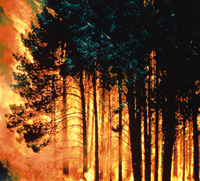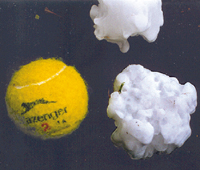


Australian Meteorology through the 20th Century
Introduction
The Origins of Australian Meteorology
Meteorology in the 20th Century
The Weather and Climate of the Twentieth Century
The Great Weather and Climate Events of the Twentieth Century
The Federation Drought, 1895–1902
The Mackay Cyclone of 1918
Northeastern Tasmanian Floods, April 1929
Black Friday in Victoria, January 1939
Record Floods in New South Wales, February 1955
Fire and Storm—Southwest WA, 1961, 1978
Brisbane Floods, January 1974
Cyclone Tracy, Christmas 1974
The 1982–83 Drought
Ash Wednesday Fires, February 1983
Sydney Hailstorm, April 1999
A Century of Progress in Science and Service
References
Australian Meteorological Milestones of the 20th Century
Endnotes
Index
Search
Help
Contact us

The 1982–83 Drought
In terms of short-term rainfall deficiencies (up to one year) and their impacts, the 1982–83 drought was probably Australia's worst in the twentieth century. It started in autumn 1982, with severe rainfall deficiencies over eastern Australia exacerbated by frequent sharp frosts in June and July. Dry conditions persisted, and by year's end extensive areas of eastern Australia had had record or near-record low April to December rainfall. The upper Murrumbidgee River became a chain of waterholes. Reservoirs throughout the southeast fell to levels unknown for many years. The northern Australian wet season failed, with record low summer rain in some areas. In February 1983, dust-storms and devastating fires swept the southeastern States, before heavy rain in late March broke the drought. In all, this drought caused losses in excess of $3b, and first brought into public prominence the link between El Niņo and Australian drought.Ash Wednesday Fires, February 1983
The severe drought over eastern Australia in 1982 led to tinder dry conditions throughout the grasslands and forests of southeastern Australia. On 16 February 1983, near-gale force northerly winds, and temperatures well over 40°C drove huge fires (many started by arsonists) across Victoria and southeastern South Australia (Figure 16). Seventy-five people died (47 in Victoria, 28 in South Australia), and nearly 2,500 houses were destroyed. The worst affected areas were Victoria's Dandenong Ranges and the Macedon area, and South Australia's Mt Lofty Ranges, all scenic areas with considerable residential populations. Forests in southeastern South Australia and Victoria's Otway Ranges were incinerated. Most deaths occurred in the hour following the cool change, when strong, gusty westerly winds turned long, narrow corridors of flame into wide fronts. The enquiry that followed led to many changes in fire weather briefing procedures, most notably the provision for regular updates on the progress of wind changes.
Sydney Hailstorm, April 1999
NSW and southern Queensland are particularly prone to large hail, normally accompanying severe thunderstorms developing along low pressure troughs. Late on 14 April 1999, a storm moving parallel to, and just off the southern NSW coast, swung north over the eastern suburbs of Sydney. Huge hailstones, some the size of tennis balls (Figure 17), and driven by squally winds, struck the city and eastern suburbs. The onslaught of ice badly damaged or destroyed many cars, partly destroyed many homes, and damaged several commercial aircraft. Many thousands of buildings, mostly homes, suffered serious roof damage.
Insurance losses exceeded $1.7b, replacing the Newcastle earthquake of 1989 as Australia's costliest natural disaster (in terms of insured losses).
 |
Bureau of Meteorology |  |
© Online Edition Australian Science and Technology Heritage Centre and Bureau of Meteorology 2001
Published by Australian Science and Technology Heritage Centre, using the Web Academic Resource Publisher
http://www.austehc.unimelb.edu.au/fam/1612.html